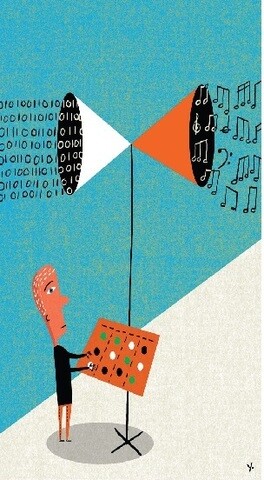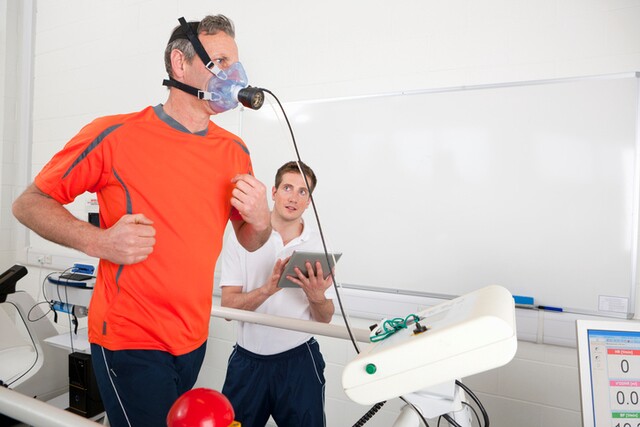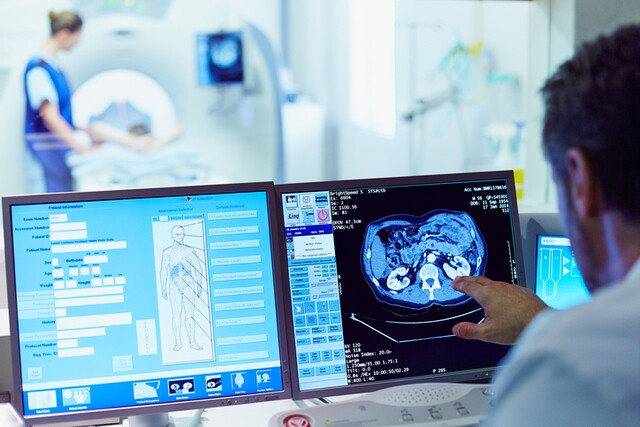This article previously ran on LDS Living in June 2016.
Have you ever heard of Philo T. Farnsworth? What about Lester Wire or Thomas Stockham?
Each of these Latter-day Saints have shaped history by inventing devices we now take for granted, including television, the traffic light, and digital sound. And while Latter-day Saints by no means have a corner on the invention market, you probably still use many of their inventions today.
Editor's Note: This is not a comprehensive list. There have been dozens of important inventions by Latter-day Saints throughout the years, but this is merely a sampling of some of the most significant ones.
1. Roadometer
The concept of an odometer was not new when the Latter-day Saint pioneers began heading west. In fact, different people, including Benjamin Franklin, had been developing their own versions of the odometer for centuries. However, the one invented by Latter-day Saint pioneers William Clayton and Appleton Milo Harmon was the first designed for use with wagon trains and is often referred to as the predecessor of the modern odometer.
Clayton, who had been charged with recording data about the journey west, wanted more specific measurements of the distance the wagon trains were going each day, instead of the estimates that had been more commonly used. He started by measuring a wagon wheel and discovered that 360 revolutions were the equivalent of one mile. After counting 4,070 rotations in one day, he consulted with Brother Harmon, who was a carpenter, to develop a machine to do the counting instead. It was more complex than most existing designs, with a series of moving spokes and gears that attached to the wagon wheel.

Thanks to this design, Clayton was able to provide fairly accurate distance measurements of the path the pioneers took. When this data was published as The Latter-day Saints’ Emigrants’ Guide, it was widely used by future pioneers, California-bound 49ers, and others traveling the same path west.
2. Improved Firearms
Jonathan Browning, a convert from Tennessee, had a prominent gun shop in Nauvoo, where he lived for some time with the Saints. A gunsmith even before he joined the Church, he loved to invent and improve on existing designs, leading to his invention of the “sliding breech” repeating rifle, often referred to as a “harmonica gun”—a precursor to modern high-capacity firearms. After being baptized, Browning continued to make guns, but began to mark them with a plate that read “Holiness to the Lord—Our Preservation.”
But if Jonathan Browning was recognized for his advances in firearms, his son was even more well known. Often called the “Father of Modern Firearms,” Ogden-born John Moses Browning followed in his father’s footsteps and is credited with over 120 patents for firearms. His most noted achievement was the invention of the automatic gas-powered machine gun. Semiautomatic pistols and shotguns also litter his list of inventions, and his guns were manufactured by the well-known Winchester and Colt companies. His contribution to military weapons was vastly important during the outbreak of World War I, and his name is still familiar to firearm users today. John Browning was a devoted member of the Church and served a mission to Georgia in 1887.
3. Television
Philo T. Farnsworth came from classic Latter-day Saint pioneer stock, with a grandfather who had followed President Brigham Young to Utah. Farnsworth was born in 1906 in Beaver, Utah, where his ancestors had settled, but he grew up on a ranch in Rigby, Idaho.
Farnsworth loved science and learned as much as he could about electricity while a teenager. In high school, he heard about early versions of the mechanical television, like those being developed by John Logie Baird in Scotland. He quickly realized that the image in these devices would never be very clear and felt he could design his own improved version. He shared an early sketch of his idea with one of his high school teachers, who then encouraged him to pursue it. Things took a difficult turn in 1924 when Farnsworth’s father died, leaving him with the responsibility of taking care of his family. He pushed forward, however, and in 1927, at age 21, he transmitted the first image on his electronic television from his lab in San Francisco.

Hearing about Farnsworth’s success, Radio Corporation of America (RCA), one of America’s largest corporations at the time, offered to buy his work for $100,000, but he refused.
As the invention caught hold, Farnsworth became very disappointed that the device was not being used for the educational purposes he had envisioned. In fact, his son Kent recalls his father saying about television: “There’s nothing on it worthwhile, and we’re not going to watch it in this household, and I don’t want it in your intellectual diet.”
Farnsworth was featured on the 1983 U.S. postage stamp, and there is a statue of him in the U.S. Capitol Building. He and his wife, Pem, were sealed in the Salt Lake Temple later in their lives. He was also posthumously presented with his Eagle Scout award, which he had earned but never received.
4. Pedal Steel Guitars
Alvin McBurney was not born into The Church of Jesus Christ of Latter-day Saints. He was an only child who grew up developing his own ham radios and learning to play the banjo.
As his music career developed through an alliance with the Horace Heidt Orchestra and the King Sisters singing group, McBurney developed a stage name that stuck with him the rest of his life: “Alvino,” the Spanish version of Alvin, and “Rey,” the Spanish word for king.
In 1935, working with Gibson company engineers, Rey’s innovative ideas and expertise led to the creation of the ES-150 guitar—the first modern electric guitar. According to his close friend Lynn Wheelwright, Rey was one of the first musicians to play the electric guitar and owned the second electric guitar ever built. Rey, however, is best known for his innovation with the steel guitar.
Dissatisfied with the tuning ability of Hawaiian lap guitars, which were commonly used in the Big Band music of his era, Rey began adding pedals and playing around with tuning shifts. With a little research and development, his ideas led to the creation of the pedal steel guitar used today.
Rey’s prototype for the electric lap steel guitar is still on display in Seattle, Washington, and he is known as the “Father of the Pedal Steel Guitar” in the Steel Guitar Hall of Fame in St. Louis, Missouri.
Rey’s wife, Luise King Rey of the King Sisters, grew up with her siblings in Payson, Utah, as a member of the Church. However, Alvino wasn’t baptized until 1968—almost 30 years after they were married. He and Luise served a mission to Hawaii in 1987 and both remained active for the rest of their lives.
5. Artificial Heart Transplant Surgery
Heart transplants have been performed by surgeons as early as the 1960s, but it wasn’t until 1982 that the idea of using an artificial heart to save lives became a reality.
Latter-day Saint Dr. William DeVries was born in Ogden, Utah, and attended medical school at the University of Utah. He was a researcher for Dr. Willem Kolff and performed his first artificial heart surgeries on animals while in this role. After a painstaking process, he became the first and only surgeon authorized by the federal Food and Drug Administration to implant an artificial heart into a human. On December 2, 1982, DeVries implanted a Jarvik-7 artificial heart into fellow Latter-day Saint Barney Clark.
Clark, a dentist with heart failure, knew the procedure was risky and did not expect to live long. However, he hoped that his surgery would help save future lives. Clark lived a surprising 112 days after the surgery, and DeVries went on to continue his work toward making artificial hearts a sustainable solution for those suffering with incurable heart disease.
Over 1,000 people attended Clark’s funeral, including DeVries and a representative for President Reagan. Elder Neal A. Maxell spoke at the funeral, calling Clark a hero: “To a world increasingly filled with hopelessness and despair, he stood quietly and resolutely for an entirely different view of life.” He went on to say that Clark was “a selfless pioneer adding a new dimension to the Latter-day Saint pioneer tradition in which those who lost their loved ones crossing the plains nevertheless picked up their handcarts and headed west.”
6. Electric Traffic Light

Picture from Getty Images
As early as 1868, attempts were being made to use traffic control devices. However, these early attempts were gas powered and proved too dangerous for use. It wasn’t until policeman Lester Wire developed a “flashing bird house” traffic control device several decades later that the first major step toward modern traffic control was made. The device, featuring painted green and red light bulbs connected to the trolley wires and manually controlled by a policeman on the ground, made its debut appearance at the intersection of 200 South and Main Street in Salt Lake City in 1912.
Salt Lake citizens originally disapproved of the device, looking upon it as a novelty item or just blatantly ignoring it. Police occasionally found that the device had been vandalized overnight and required time for repairs. Wire patiently continued to improve on his idea, though, and eventually developed a more durable, metal model of the traffic light using a locomotive smokestack. Unfortunately, by the time he thought about having the invention patented, several other cities already had their own versions of the system, patented by other men. Wire’s first electric light box was used as an actual birdhouse in Salt Lake’s Tracy Aviary for several years until it disappeared shortly after his death.
7. Digital Sound
An Emmy Award winner in 1988 and Grammy winner in 1994 for his work with recording, Thomas Stockham was a pioneer in the digital sound field along with his mentee, Robert B. Ingebretsen, and colleague, Richard B. Warnock. All three were members of The Church of Jesus Christ of Latter-day Saints and Stockham and Ingebretsen received a joint Oscar Award in 1999 for their work in digital audio editing.
Stockham was an MIT graduate with a Ph.D. and began experimenting with digital sound not long after graduating. He spent some time at the University of Utah, where he became the mentor for Robert B. Ingebretsen. While there, Stockham developed a way to digitize old records. Around this time, he also founded the company Soundstream in 1975, which released the first of these digitally remastered recordings. His revolutionary technique for removing unwanted noises from the recordings astonished crowds and Stockham continued to find ways to improve the technology.
Warnock and Ingebretsen eventually joined their colleague at Soundstream. Using Stockham's ideas, Warnock, as Chief Electrical Engineer, designed the hardware and Ingebretsen wrote the software for the first practical digital audio editing system. After Ingebretsen failed to file the patent papers, Sony and Philips beat Soundstream to producing CDs in the early 1980s. But the discovery of digital recordings as an easier way to seamlessly splice together music recordings is still attributed to those key inventors at Soundstream.

Illustration by James Yang
Stockham was a key player in the attempt to recover the erased minutes on the tape in the Watergate scandal and has come to be known as the “Father of Digital Recording.” One of Ingebretsen’s other notable achievements includes his work with fellow Latter-day Saint Ed Catmull to create the first digital movie—a 20-second portrait of a hand.
8. Hearing Aid
Latter-day Saint Harvey Fletcher was born in Provo, Utah. After graduating from BYU in 1907, he attended the University of Chicago, where he and his mentor, Robert A. Millikan, began trying to measure the charge of an electron. His research and discoveries there would later prove vital to his invention of the 2-A audiometer—a predecessor to the modern electric hearing aid.
In 1911, he became the first summa cum laude Ph.D. graduate from the University of Chicago physics department, and a few years later he began working for what would become Bell Laboratories. Through his research in sound, he developed the first hearing aid to use vacuum tubes and has since come to be known as the “Father of Stereophonic Sound.”
The first presentation of three-dimensional sound was given by Fletcher in the early 1930s. Many were astonished by the realistic sounds coming from the stage. A few years later, he used this same stereo sound recording technology to give a concert in Carnegie Hall, and even occasionally featured recordings of the Tabernacle Choir in later similar demonstrations.
Fletcher left a mark in many other ways as well. In his years of studying speech sounds, he developed a vibrating reed machine that functioned similarly to the vocal cords, which easily allowed for the development of the artificial larynx for those without vocal cords. He also pioneered work on adding recorded sound to make “talking pictures” and even developed a hearing aid for the famous inventor Thomas Edison.
Dr. Fletcher was a dedicated member of the Church throughout his life, serving as president of the New York Branch and in various other Church leadership roles.
9. Artificial Diamonds
Though you won’t find these crystals in a jewelry store, synthetic diamonds have found an invaluable use in industry. And the man responsible for their invention? Latter-day Saint Howard Tracy Hall.
Hall, who was born in Ogden, Utah, looked up to Thomas Edison and dreamed of working at General Electric—a company closely associated with Edison. Hall received both a bachelor’s and master’s degree from the University of Utah before he fulfilled his dream by starting work in a research laboratory for General Electric.

Illustration by James Yang
He spent many hours researching and experimenting in an attempt to recreate the natural diamond-making process. He finally did so in 1954, creating the first commercial synthetic diamonds, which measured only thousandths of an inch. This scientific breakthrough earned Hall the title of the “Father of the Synthetic Diamond.” He later took a research job at BYU before developing and patenting a more efficient tetrahedral press and founding the industrial diamond making company MegaDiamond. Synthetic diamonds are used today to cut other diamonds, grind and shape dozens of different tools, drill for oil, and prepare granite kitchen countertop slabs among other things.
Hall and his wife, Ida-Rose, were faithful members of the Church their entire lives. Hall served as a bishop for several years, and he and his wife served a mission together in South Africa from 1982 to 1983.
10. Lasers in Surgery
Provo-born John Aldous Dixon earned his bachelor’s degree in 1944 and became a Doctor of Medicine in 1947 at the University of Utah. A pioneer in the medical field, Dixon was Ogden’s first board-certified gastrointestinal surgeon and did a lot of research on using lasers in surgery. He wrote a book about his research and discoveries called Surgical Applications of Lasers, which was published in 1983. By using a hair-thin quartz tube and a viewing device, Dixon was the first to use a laser to successfully treat ulcers and tumors, particularly in the gastrointestinal area.
Today, lasers are used in the majority of specialty surgeries as a way to stop bleeding.
Dixon served as a bishop, high councilor, and later as a leadership missionary with his wife, Karma.
11 and 12. Kidney Dialysis Shunt and Lightweight Treadmill
If you or anyone you know has ever required kidney dialysis, you should know it was a Latter-day Saint who helped make that easier.
Wayne Quinton, a Latter-day Saint born in Rigby, Idaho, started work as a master layout draftsman for Boeing B-29 bomber planes in 1941, shortly after Pearl Harbor. He eventually began work at the University of Washington, where he earned a mechanical engineering degree in 1959.
Quinton loved to learn and studied across multiple fields, allowing him to connect the engineering and medicine worlds. This led him to become a pioneer of bioengineering. One of the most notable contributions he made was a revolutionary kidney dialysis shunt developed through a collaborative effort with Belding Scribner in 1960. The device allowed patients to easily reconnect to a dialysis machine, an important and life-saving job for those with kidney disease.

Arguably just as significant was Quinton’s lightweight treadmill, developed several years before the kidney shunt in the early 1950s. Though not the first treadmill ever invented, Quinton’s model was specifically designed for use in doctors’ offices to test heart patients. When Quinton launched his own company to market some of his inventions, the lightweight treadmill quickly became standard in the industry. Modernized versions of his original model are still used today in gyms, fitness centers, and homes.
Despite initial doubts about the Church and its members, Quinton studied the Church and Joseph Smith from a scientific perspective before finally deciding to listen to the gospel message. He was baptized in 1956 at age 35 and maintained a strong testimony.
13. Gore-Tex
Robert W. Gore, the inventor of the waterproof fabric Gore-Tex, was born the oldest of five children in Salt Lake City, Utah. Gore’s father worked as a research engineer for DuPont—the company responsible for the invention of Teflon. But Gore, who was a chemical engineering student at the time, had an idea for using Teflon to make wire insulation, which led his father to form W.L. Gore & Associates in 1958 and patent his son’s idea.
Gore joined the family firm as an official researcher soon after receiving his doctorate from the University of Minnesota in 1963 and continued experimenting. Part of his new research involved looking for ways to make Teflon into better cables. In 1969, after many failed attempts to slowly stretch the heated material (it would simply break each time he tried), he finally yanked it in frustration, which, to his surprise, caused it to stretch. This led to the development of a breathable fabric, which was named Gore-Tex, after its inventor.
Today, Gore-Tex is used in a variety of products and industries. However, it is still best known for its use in outdoor clothing and footwear such as hiking boots. It is even used by participants in expeditions to Antarctica and was used in the spacesuits for NASA’s first shuttle mission. Because of their durability, Gore-Tex cables were also used during NASA’s first unmanned mission to the moon.
14. Medical informatics (Computers in the Medical Field)
Until Dr. Homer R. Warner came along, using computers to measure and analyze medical data was unheard of. Warner, a Ph.D. graduate from the University of Minnesota in 1953, had studied both math and engineering, which made him the perfect candidate for fusing computers with the medical field. His first major breakthrough was at the Mayo Clinic a year after graduating, where he created a way to accurately measure the amount of blood the heart pumps each time it beats. Before this time, doctors could only guess. From there, he went on to develop a computer system that could use information to more accurately diagnose heart disease patients than a physician could on their own.

Warner’s research was also influential in medical genetic research in the early 1970s, aiding several fellow Latter-day Saint physicians at LDS Hospital as they used family history records and other government and health records to compile information on ailments such as cancer and heart disease into the Utah Population Database. According to the Huntsman Cancer Institute website, this database is still used today for over 200 research projects.
Warner and his first wife, Kay, were married in the Salt Lake Temple in 1946 and served as medical missionaries in Europe from 1996 to 1997. After Kay passed away, Warner married Jeanne Okland, and after Jeanne’s passing, he married June Okland Cockrell.
Othe photos from Getty Images



